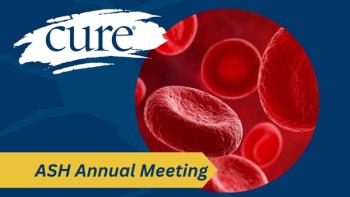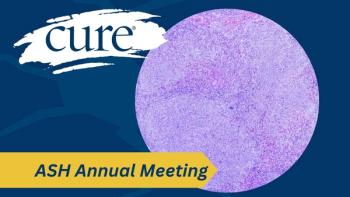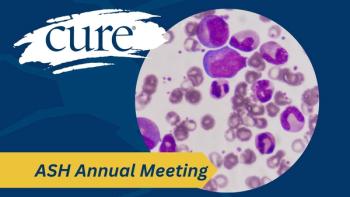
- CURE® Women's Cancers 2021 Special Issue
Preserving Fertility in Adolescent and Young Adult Women with Cancer
How should fertility preservation be addressed in patients who may not be thinking about having children yet?
Emma Vivian and her husband were looking forward to 2019. The couple, married for five years, were ready to start a family. But in December 2018, they found themselves sitting numbly at a cancer center as a breast surgeon explained that 29-year-old Vivian had stage 1b triple-positive breast cancer. The recommended treatment plan included a mastectomy, months of chemotherapy and perhaps immunotherapy or biotherapy, followed by years of estrogen-blocking anastrozole plus Lupron (leuprolide acetate) injections. At the end of the conversation, the doctor cautioned that the cancer treatments meant to save Vivian’s life could affect her ability to have a baby.
For the first time, Vivian broke down. “It was horrific enough to get a cancer diagnosis when I wasn’t yet 30,” she says. “To find out that your dream of having a child might be lost was too much to bear.” Still, Vivian was grateful that her doctor brought up fertility preservation. “Since starting cancer treatments, I’ve met other women with cancer who didn’t know that they might not be able to have children,” she says.
This lack of knowledge can have long-lasting implications for cancer survivors. Research shows that women who find out about infertility risks after getting cancer treatments (when the opportunity for fertility preservation has passed) experience more severe depression and grief than those who knew about the risks beforehand.
The good news: More oncologists are discussing fertility with their adolescent and young adult patients, often at the same time they first discuss cancer treatments. The timing is critical. “Depending on the cancer type and stage, there can be a very short window of opportunity for fertility preservation to happen before cancer treatments must start,” says Dr. Mahmoud Salama, director of The Oncofertility Consortium at Michigan State University in East Lansing.
But there’s still a lot of work to be done in oncofertility, a term coined in 2006 to bring the fields of oncology and fertility medicine together to help children, adolescents and young adults who have cancer. That same year, the American Society of Clinical Oncology issued guidelines urging oncologists to discuss the possibility of infertility as a cancer treatment side effect and to refer patients to fertility specialists when needed. Three years later, a national survey found that fewer than 50% of people with childhood and gynecologic cancers were aware of these infertility risks.
Oncofertility: Helping Women with Cancer Conceive
Chemotherapy and radiation therapy are commonly used to treat breast and gynecologic cancers. Some of these anticancer therapies are also highly gonadotoxic, meaning they can temporarily or permanently damage a woman’s ovaries. “Radiation therapy can (sometimes) cause the ovaries to fail, putting a woman into early menopause,” says Kristin Smith, program manager for fertility preservation at the Adolescent and Young Adult Cancer Program at the Robert H. Lurie Comprehensive Cancer Center of Northwestern University in Chicago. “And chemotherapy drugs can’t distinguish between rapidly dividing cancer cells and the active cells in ovaries that produce eggs. They go after both.”
Egg freezing, or cryopreservation, is the simplest fertility preservation method for women. “A woman gets daily hormone injections for about two weeks to stimulate egg production, and then has an outpatient procedure to retrieve the eggs, which are frozen and stored,” says Dr. Elizabeth Constance, a reproductive endocrinologist and fertility preservation specialist at Heartland Center for Reproductive Medicine in Omaha, Nebraska. Egg retrieval needs to happen first, which means there can be a two-week delay in the start of cancer treatments. “We always work with the oncologist to prioritize the patient’s health over fertility preservation,” Constance says.
Unfortunately, the hormones that stimulate egg production also can feed the growth of estrogen hormone-positive cancers such as Vivian’s triple-positive breast cancer. When Vivian decided to freeze some of her eggs, she took letrozole to keep estrogen levels from surging too high. Letrozole is a nonsteroidal aromatase inhibitor that suppresses the body’s natural production of estrogen. Doctors typically use it to treat breast cancer in postmenopausal women.
A woman may need to wait one to five years after finishing cancer treatments to try to conceive. In vitro fertilization (IVF) can be used to fertilize some of the previously frozen eggs. Laboratory clinicians mix sperm from a woman’s partner or a donor with the eggs, which have been thawed. Another option is intracytoplasmic sperm injection, which injects sperm directly into an egg. The fertilized egg, now an embryo, is then placed into the woman’s uterus where it hopefully implants and starts to develop.
Some women freeze embryos instead of unfertilized eggs, a method that has been in use since the 1980s. Freezing a fertilized egg is more successful in achieving pregnancy than freezing eggs and fertilizing later, although this requires a partner or anonymous donor. Once frozen, embryos and eggs don’t age. “Eggs retrieved from a 22-year-old woman remain 22 indefinitely,” Smith explains. This means a woman in her 40s can conceive with a frozen egg or embryo that is younger and theoretically healthier. Women older than 40 who conceive naturally have an increased risk of having a child with Down syndrome, autism or other chromosomal problems. Conceiving with a previously frozen young egg or embryo lowers this risk.
For prepubescent girls with cancer who haven’t started to produce mature eggs, ovarian tissue freezing is the only option. This method also can help teens and adult women. “Doctors surgically remove part or all of an ovary, leaving the other ovary in place in the hopes of preserving natural hormone production in the future,” Constance says. Thin strips of ovarian tissue are frozen and stored. These tissue strips can contain follicles with thousands of immature eggs. At a later date, a doctor surgically implants the thawed tissue back onto a woman’s remaining ovary or into the pelvic region. The hope is that the tissue starts releasing eggs on its own for natural conception or can be stimulated to produce eggs through IVF.
The first baby conceived through ovarian tissue freezing was born in 2004 to a Belgian woman who froze tissue seven years earlier before getting chemotherapy to treat Hodgkin lymphoma. She became pregnant naturally 11 months after the tissue reimplantation. In 2005, an infertile American woman (who didn’t have cancer) became pregnant after receiving an ovarian tissue transplant from her identical twin sister.
More than 300 babies have started life this way. But it wasn’t until December 2019 that the American Society for Reproductive Medicine lifted the experimental label, giving more girls and women with cancer the opportunity to freeze ovarian tissue. Because the procedure is relatively new, many fertility clinics don’t offer it yet. In addition, there’s a chance that the tissue may have cancer cells that can start to grow when reintroduced into the body. “We think this risk is greatest if you have a blood cancer (such as) leukemia or an ovarian malignancy,” Smith says.
Ovarian transposition (or oophoropexy) is another surgical procedure that may protect the fertility of prepubescent girls and young women with cancer who need radiation therapy to the pelvic area. “Usually via laparoscopy, we move one or both ovaries away from the field of pelvic irradiation,” Salama says. After the patient finishes her radiotherapy, becomes cancer free and is fit to become pregnant, the ovaries could be placed back surgically into their original anatomical sites to help natural conception. If natural conception does not occur, IVF can be attempted.
When this procedure takes place in children, the ovaries, fallopian tubes and uterus often stay connected. In adults, doctors may disconnect the ovaries and tubes from the uterus. They can’t be reattached, but doctors can stimulate egg production and use IVF for conception. Moving the ovaries won’t protect them against systemic treatments such as chemotherapy.
Doctors also can take measures during cancer treatments to protect fertility. “Hormone suppression drugs such as Lupron (leuprorelin) or Zoladex (goserelin) can put the ovaries into hibernation during chemotherapy,” Constance says. “This may make cells in the ovaries less sensitive to damage because they aren’t actively trying to make eggs.” Menopausal symptoms are an unfortunate drug side effect. “I had a fan on my desk to help with the hot flashes,” says Maggie Davis, who was 24 when she took Lupron in 2013 during chemotherapy to treat stage 1 breast cancer.
The drug may have made a difference. In 2016, Davis, who lives in Marietta, Georgia, gave birth to a daughter conceived naturally. The eggs she froze before starting cancer treatments remain untouched. “My doctor said that I might need to use the eggs in the future,” she says. “There’s no way to know for sure until I try to get pregnant again.”
The High Cost of Fertility Preservation
Davis knows she’s fortunate to have had the opportunity to freeze her eggs and to not yet need them. “When I learned that egg freezing was going to cost almost $7,000, I didn’t think I could afford to do it,” she says. Fees for fertility preservation vary depending on the method and even the clinic location and doctor. “The medications to stimulate egg production can run as high as $6,000,” Smith says. “And then you still have to pay for the egg retrieval and annual storage fees.” The cost can reach $15,000, and there’s no guarantee that it will work. IVF with fresh eggs is effective about half of the time. Using frozen eggs or embryos may lower those odds.
Only 10 states have laws that require health insurers to cover some of the costs of fertility preservation procedures. Some fertility clinics offer discounts for people with cancer. Still, these expenses come at a time when women are also facing hefty charges for cancer care.
Vivian received her diagnosis toward the end of the year, which meant she paid two years of insurance deductibles in quick succession. The egg cryopreservation fee was $12,000. The couple borrowed money from family, and friends helped to raise money through a crowdfunding effort.
Davis was in a similar predicament. “I looked into a payment plan, but it cost $150 just to apply,” she says. If she was approved for the plan, she was told the interest rate could be as high as 30%. Instead, Davis’ mom, Mary Jones, helped out. Wanting to repay her mom, Davis began selling T-shirts emblazoned with “Team Maggie.” During a chemotherapy session, Davis and Jones discussed how unfair it was that young people with cancer might forgo fertility preservation because the costs were out of reach. Six months later, Team Maggie’s Dream was born.
The nonprofit organization provides fertility assistance grants to people ages 15 to 37 who have cancer.
“My daughter, Layleigh, is the best thing to ever happen to me,” Davis says. “She was a bright light after a dark period. It’s reassuring to know that I have options if I need help giving her a younger brother or sister. It would be wonderful for every young person with cancer to have this same opportunity.”
For more news on cancer updates, research and education, don’t forget to
Articles in this issue
over 4 years ago
Thinking of the Future During Cancer Treatmentover 4 years ago
Balancing Cancer Screenings and COVID-19 Safetyover 4 years ago
Having the Ball in Your Court Helps You Fight Cancerover 4 years ago
Embracing a Different Perspective After Ovarian Cancerover 4 years ago
15 Years Later, What Have We Learned About the HPV Vaccine?over 4 years ago
Targeted Therapies Take Aim at Endometrial Canceralmost 5 years ago
Many Women Are Satisfied After 'Going Flat' Post-Mastectomy, Study Finds




